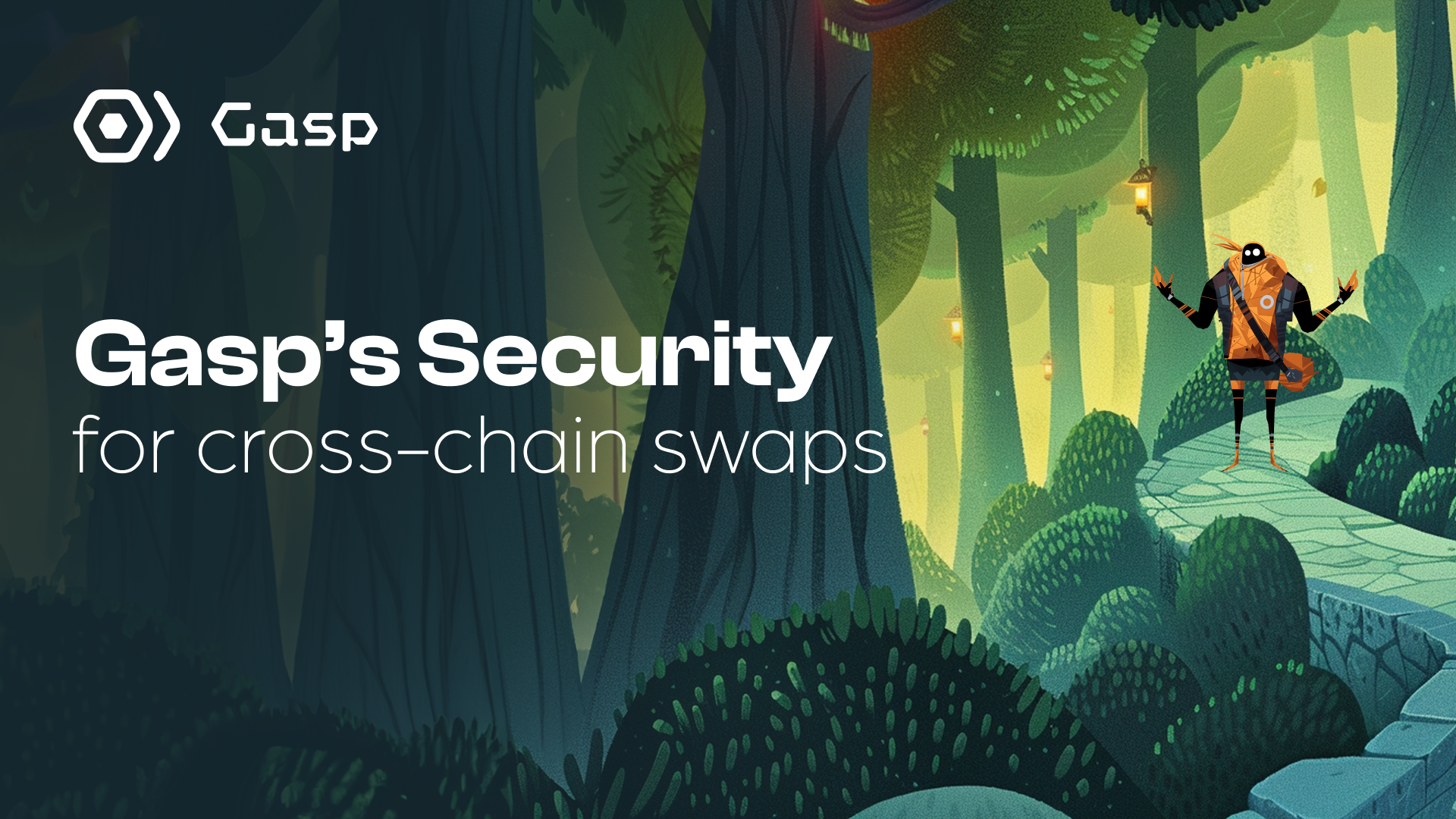Gasp’s Security For Cross-Chain Swaps

When trading across blockchains, security is crucial to ensure the reliability of the network. Gasp’s security infrastructure is essential to enable a safe, native cross-chain trading environment.
In this article, we will explore the security components of Gasp and how it ensures safe and reliable cross-chain trading by preventing attacks, maintaining transaction integrity, and guaranteeing finality across multiple blockchains.
The Gasp security framework
Gasp is a secure, cross-chain decentralized exchange infrastructure that eliminates the need for traditional bridges. By integrating a solution that processes transactions off-chain while relying on the security of the underlying Layer 1 (L1), called a ZK-rollup framework, Gasp connects multiple EVM-compatible blockchains (more in the future).
This framework enables scaling on Layer 2 (L2) solutions, while still relying on the security of the underlying Layer 1 (L1), forming a shared security tandem. However, challenges arise when interacting with states and assets from different ecosystems.
When conducting transactions between different chains, communication between them is a challenge. For example, if a user holds $BTC and swaps it for $ETH, the Ethereum blockchain views the ownership of $BTC as external state information. Since this information comes from a chain outside of Ethereum, it cannot be verified by the Ethereum blockchain.
This highlights a key limitation of ZK-rollups: while they perform effectively within their native Layer 1 (L1) environments, they are unable to validate transactions across different chains.
To address this limitation, Gasp utilizes EigenLayer’s restaking capital, which leverages Ethereum’s robust economic security to validate cross-chain transactions. By tapping into EigenLayer’s restaked security, Gasp ensures that cross-chain swaps are validated securely while preserving the integrity of each token's native Layer 1 (L1) blockchain through a neutral party.
Handling Security Risks
Gasp operates as a blockchain that manages state transitions across multiple rollups, enabling it to interact with various Layer 1 blockchains. This structure is called a master-rollup. In this setup, Gasp ensures the validity of Layer 1 (L1) reads as incorrect L1 data can compromise the entire cross-chain transaction process. If invalid data is accepted in one system, it can spread across other connected L1 blockchains through token swaps, leading to corrupted states across the network. Since external L1 information cannot be verified by other connected blockchains, preventing the spread of incorrect reads is a critical security concern.
This is where rolldowns come into play. A rolldown is a solution designed to disincentivize and prevent incorrect L1 reads from being processed. In a rolldown, if at least one sequencer remains honest, invalid data is blocked from being accepted. Similar to how rollups ensure that only correct L1 writes are processed, rolldowns ensure that only valid L1 reads are accepted.
Rolldowns enable sequencers to veto an incorrect L1 read. To achieve this, L1 reads are kept pending on both L1 and L2. They are not immediately processed, giving the system time to confirm their validity. While in this pending state, a dispute period occurs on L2, during which sequencers can review, approve, or cancel reads. If a read is canceled, it is removed from the pending queue, along with any subsequent reads, preventing it from affecting the state of the network.
To further secure the system, rolldowns are designed so that only one honest sequencer is required to maintain the integrity of the process. Each sequencer needs to put capital at stake, which serves as an incentive for honest behavior. If all but one sequencer attempts to act maliciously, the honest sequencer can reject all invalid reads. The honest sequencer can then submit proof of the malicious behavior to the Layer 1 blockchain. In doing so, the dishonest sequencers are penalized (slashed), and the honest one is rewarded for preserving the network’s integrity.
Rolldowns are an essential mechanism within Gasp’s architecture, designed to safeguard the integrity of cross-chain transactions by validating only correct L1 reads, ensuring that no malicious or erroneous data can compromise the system.
MEV Protection
Miner Extractable Value (MEV) is a critical DeFi security concern. MEV refers to the potential profit that malicious actors can extract by reordering, censoring, or front-running transactions in a blockchain's mempool – the queue where transactions wait to be included in a block. Attackers can exploit the mempool by scanning transactions, identifying patterns, and reordering them for personal gains, often at the expense of other users.
Front-running (where an attacker submits a transaction just before a user's to benefit from price changes) and sandwich attacks (where an attacker places transactions before and after a user's to manipulate prices), create significant power imbalances and diminish the fairness of the network. This is called “MEV extraction” and not only undermines the network’s integrity but can also result in substantial financial losses for traders.
To mitigate these risks, Gasp has an MEV protection mechanism that prevents malicious actors from manipulating the mempool. By hiding transaction details until execution and using randomized transaction ordering, Gasp makes it difficult for attackers to predict or interfere with trades. This approach effectively neutralizes front-running, sandwich attacks, and other MEV exploits, ensuring confidentiality and integrity in cross-chain transactions.
Ensuring Transaction Finality
Transaction finality refers to the point at which a transaction is considered permanent and cannot be altered or reversed. For cross-chain decentralized exchanges like Gasp, fast and decentralized transaction finality is essential to secure asset transfers.
In Gasp’s architecture, EigenLayer plays a central role in achieving transaction finality. By leveraging EigenLayer, Gasp benefits from a decentralized, trustless system that ensures state transitions are validated and finalized across multiple blockchains. This prevents any malicious actors from altering transaction data once it has been finalized. Since cross-chain transactions inherently involve multiple ecosystems, Gasp uses EigenLayer to maintain the integrity of these transfers by using Ethereum’s economic security as the backbone.
Once a transaction in Gasp is finalized through EigenLayer’s security framework, it becomes permanent, and cannot be reversed, ensuring user confidence. This ensures that Gasp can provide a secure and reliable cross-chain trading experience while maintaining the highest standards of security and finality across different blockchains.
Conclusion
Security is the cornerstone of Gasp’s cross-chain DEX and liquidity protocol, ensuring safe and reliable asset transfers across multiple blockchains. By leveraging EigenLayer's economic security and implementing protections for MEV minimization, Gasp fosters a secure and equitable trading environment.
Stay informed. Join our mailing list for exclusive updates on Gasp's token launch and insights into secure cross-chain transactions. Visit our testnet app and sign up to be the first notified of the launch!
Official Links
- Website: https://www.gasp.xyz/
- Testnet: http://holesky.gasp.xyz/
- X (Twitter): https://twitter.com/gasp_xyz
- Discord: https://discord.gg/gasp-xyz

